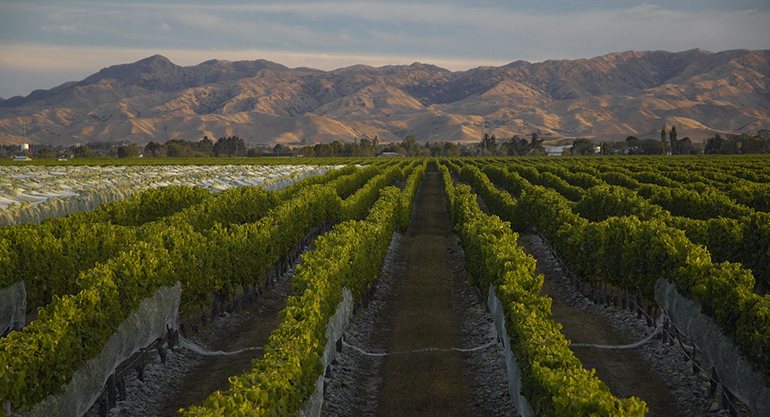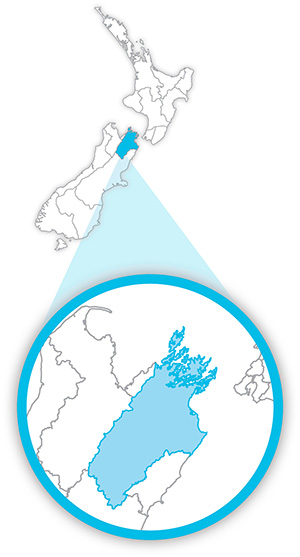Ngā kōrero mō tēnei rohe | Our regional story
On this page

© MarlboroughNZ
Te Pokohiwi o Kupe, located on the Wairau Bar, was settled by Māori as early as the 13th century. Local tangata whenua refer to the area as the tūrangawaewae for the first people of Aotearoa, making Wairau Bar; the birthplace of the nation. Over the years our population has grown and now around 50,000 people call Marlborough home.[4]
Our regional economy is primarily focused on how we use the land and the sea with agriculture, forestry and fishing, and manufacturing contributing to more than 30% of our GDP.[5] Marlborough has an innovative streak, and has led the country with our wine, aquaculture and aviation industries (Source: Infometrics Marlborough Regional Profile 2021).[6]
We have worked with the Marlborough District Council as they developed Marlborough’s Economic Wellbeing Strategy, which we see as complementary to our work and this Plan for this region.
Ō mātou tāngata | Our people
Marlborough’s age profile is older than the national average (our average age is 45.3 years compared to 37.7 nationally).[7] This is driven by the attractiveness of Marlborough as a retirement destination as well as the tendancy for our young people to leave the region once they have finished secondary school.
The population of the region is predomintly NZ European (88%), with 13% of people indentifying as Māori and smaller Asian (4%) and Pacific (3%) communities.[8] Over the next 15 years Marlborough will become more diverse, and the share of people who identify as Māori is expected to grow to over 20%.[9]
About one in four people are disabled or have some form of health condition.[10] This ranges from mobility issues to anxiety and depression. Disabled people have lower participation in the labour market than non-disabled people, despite many of these people being willing and able to work.[11] The Government has developed Working Matters, an action plan focused on ensuring disabled people and people with health conditions can participate in employment as they want to, on an equal basis to others.
Tō tātou ao tuku mahi | Our labour market
There are about 7,000 businesses in Marlborough.[12] Like the rest of New Zealand, fewer than 1% are large businesses that employ over 100 people. The remaining 99% are small to medium sized enterprises. Sixty-nine per cent do not employ anyone (these are likely owner operator businesses). We worked to identify our largest businesses and engaged with all of them in developing this plan, over 60% provided feedback.
There are about 27,000 filled jobs across the region.[13] Nationally, Marlborough has the largest share of workers (21%) working in the Agriculture, forestry and fishing sector and the third largest share of workers employed in Manufacturing (13%). These industries represent our largest sectors by share of employment. The next three largest sectors for filled jobs are the Retail trade (9%), Construction (8%) and Healthcare and social assistance (8%).[14]
Agriculture, forestry and fishing is also the top employing sector for Māori (15%). This is followed by Manufacturing (14%), Construction (11%), Accommodation and food services (10%), and the Retail trade (9%).[15]
In addition, there are about 5,800 people in the region who are self-employed.[16] The largest shares of self-employed people work in Agriculture, forestry and fishing (22% of all self-employed people), Construction (15%) and Professional, scientific and technical services (11%).
We have historically had a low rate of unemployment (currently 3%) and we have a tight labour market.[17] The unemployment rate for Māori is higher at around 5%.[18] Employers consistently report that there are not enough people in the region to fill the available roles.
Despite this, we have historically low rates of participation in the labour force and a high rate of underutilisation. This may be in part due to our older population, but is also a sign that we have some capacity in our labour market. There are specific groups within our community that have lower participation in the labour market, including young people, Māori, disabled people and women.
With 16% of people working in unskilled jobs, Marlborough has a higher number of people working in unskilled and low-skilled jobs compared to the national average of 13%. Along with Nelson-Tasman, Tairāwhiti and Hawke’s Bay we have the highest proportion of workers in unskilled roles. Correspondingly, our region has the lowest share of highly skilled workers (35.6%).[19] This is reflected in Marlborough’s low mean earnings figure ($58,897 compared to $65,910 nationally).[20]
Footnotes
[4] Population estimates 2020(external link) — Stats NZ
[5] Population estimates 2020(external link) — Stats NZ
[6] Infometrics Marlborough Regional Profile 2021
[7] Median Age at 30 June 2021(external link) — Stats NZ
[8] Census 2018(external link)(external link) — Stats NZ
(N.B. %s do not total to 100, as people can identify with more than one ethnicity)
[9] Population estimates by regional council(external link) — Stats NZ
[10] New Zealand Disability Survey 2013(external link) — Stats NZ
(Note these are New Zealand level figures)
[11] Labour market statistics (disability): June 2021 quarter(external link) — Stats NZ
[12] Business demography, February 2020(external link) — Stats NZ
[13] Employment indicators – February 2022(external link) — Stats NZ
[14] MBIE Detailed Regional Employment Estimates
[15] Census 2018(external link)(external link) — Stats NZ
[16] Self-employment by ANZSIC 1-digit industry 2021(external link) — Infometrics
[17] Householder Labour force Survey – December 2021(external link) — Stats NZ
[18] Census 2018(external link)(external link) — Stats NZ
[19] MBIE Detailed Regional Employment Estimates
[20] Mean Annual Earnings 2021(external link) — Infometrics
He aha ngā tautāwhitanga o tēnei rohe? | What inhibits our region?
Throughout our consultation in developing this plan three clear inhibitors were identified as impacting on people’s desire and ability to live and work in Marlborough. We acknowledge the impact that these issues have on our region and have approached them from a skills and labour perspective.
Housing
Almost everyone we have spoken to has identified the lack of housing (rentals and cost to buy) as a limitation on people moving to and staying in the region. Housing issues were also identified in the Te Tauihu Intergenerational Strategy as a key area of focus (Te Rakau Taumatua – Place: Smart and Affordable Housing Solutions). We have heard from employers about successful candidates turning down roles because they haven’t been able to secure housing in the area and people moving out of the region due to the lack of housing.
This is greatly affecting Marlborough’s brand and attractiveness as a region, which is in turn impacting on our ability to attract and retain key workers, such as teachers, doctors, and those who work in the regions’ key sectors.
Affordable and secure housing also plays a role in supporting people to study. The lack of student accommodation was identified by youth as a barrier to studying in Marlborough
The RSLG will support the building and construction sector to develop the appropriate workforce to support housing initiatives in the region. We will also continue to raise housing issues with the Government and our community through our regular local insight reports.
Health
The health sector impacts Marlborough in a number of ways. As a region we suffer from shortages across most roles, from surgeons and GPs to nurses and care providers. These shortages in health workers are long standing and there is limited training available in the region across all parts of the health sector. Due to a limited number of doctors and other health care providers, some people struggle to find primary health care providers. Anecdotally, we have heard that this is a barrier for people looking to move to Marlborough.
Health care and social assistance is a large employer in the region and is forecast to be one of our largest growing sectors over the next 15 years. We need to ensure that we have the workforce to meet this demand.
For our 2022 RWP we have focused on aged residential care. However, the recommendations regarding offering training for nurses and other opportunities for people to upskill in the health sector will provide benefits across the whole sector. Looking forward to future plans, we will review the scope of our healthcare focus in consultation with our community.
Education
The importance of our education system, especially secondary schools was also raised by a number of stakeholders. Marlborough students have slightly lower than the national average NCEA achievement rates and these rates are even lower for Māori (% of students leaving school with NCEA Level 2+: Marlborough 80%, Marlborough Māori 71% and New Zealand 81%).
Marlborough Region School Qualifications: NCEA Level 2(external link) — Education Counts 2019
(% of students leaving school with NCEA Level 2+ (Marlborough 80%, Marlborough Māori 71% and New Zealand 81%) )
We have heard that some people have chosen to move out of the region when their children reach secondary school age because of perceptions around (the lack of) achievement and opportunities.
Our vision for the future of Marlborough includes a 21st century education system that supports lifelong learning. We are looking to work with schools and industry to ensure that education is relevant and has a real-world application. Our hope is that this will increase the engagement of students and improve outcomes.
Marlborough sub-population and main employing industries
 Picton & the Sounds
Picton & the Sounds
9,000 people
Accommodation and food services 19%
Agriculture, forestry and fishing 18%
(Tourism and aquaculture)
Blenheim
29,000 people
Health care and social assistance 13%
Agriculture, forestry and fishing 11%
Wairau
12,000 people
Manufacturing, agriculture, forestry and fishing 55%
(Grape growing)
Awatere
1,800 people
Agriculture, forestry and fishing 60%
(Grape growing and farming)

